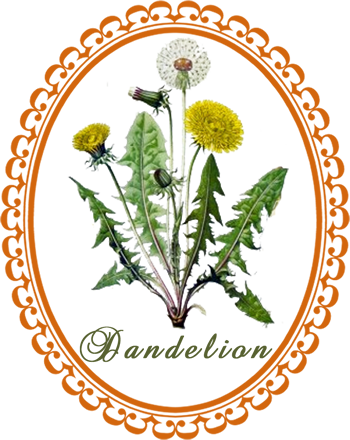
Dandelion: the leaves of this golden-flowered weed are rich in vitamins A, B, C and D, as well as potassium, zinc, iron and calcium ...
Common Names: Dandelion, Blow Ball, Lion's Tooth, Wild Endive
Botanical Name: Taraxacum officinale
Family: Asteraceae
Plant Type: Hardy perennial
Parts Used: Roots, leaves, and flowers
Flowering: May - June
Native to Europe and Asia, dandelions grow in temperate regions of the world, in lawns, on roadsides, on disturbed banks and shores of water ways, and other areas with moist soils. They were introduced into the Midwest from Europe to provide food for the imported honeybees in early spring. They now grow virtually worldwide.
Description: Dandelion is a small perennial with a stout taproot, and toothed leaves up to 30 cm long that form a tight rosette. Smooth leaves are bright green with uneven, jagged margins of backward pointing teeth, and for this reason the plant has been given the name dandelion which comes from the French ‘dent de lion’, meaning lion’s tooth. Yellow, solitary flowers arise from the centre of the rosette and develop into spherical, "seed" heads with fluffy parachutes to carry each seed away in the wind, nature’s way of plant preservation. All parts of the plant exude a slightly bitter, milky substance.
Cultivation: Dandelion enjoys a rich, well-drained soil in full sun.
Harvesting: Pick young, fresh leaves and flowers any time; collect leaves to dry when in flower. Dig roots in second autumn. Use fresh, or dry.
Culinary Uses: Make dandelion wine from (unsprayed) dandelion flowers. The young greens are more nutritious than spinach and are eaten fresh in salads. The shiny green leaves contain 7,000 units of vitamin A per ounce and are an excellent source of vitamins B, C, and G. As a comparison, vitamin A content in lettuce is 1,200 units per ounce and carrots have 1,275 units per ounce. Mince the flowers and use as a garnish or to add color to spreads and butters. Dandelion root cut up and dried is used for coffee by health-minded people. From a health point of view, it is more desirable to drink than coffee or tea. For this purpose it is frequently combined with roasted acorns and roasted rye in equal parts, or according to taste.
Dandelion Magick
Divination. Psychic Powers.
Gender: Masculine
Planet: Jupiter
Element: Air
A tea made from the root promotes psychic powers.
This same tea, steaming and placed beside the bed, will call spirits.
Dandelion, buried in the northwest corner of the house, will bring favorable winds.
To send a message to a loved one, blow at the seed head in his or her direction and visualize your message.
Herbal Healing with Dandelion
Medicinal Actions: Cholagogue, diuretic, hepatic, laxative.
Medicinal Uses: Dandelion is a powerful diuretic, and rather than deplete the body of potassium (which helps control fluid balance), it replaces it. The natural nutritive salt in dandelion is twenty-eight parts sodium; this type of organic sodium purifies the blood and destroys the acids therein. It is specific for cases of congestive jaundice. It can be used to treat inflammation of the liver and gallbladder. It is of an opening and cleansing quality and therefore very effective for obstructions of the liver, gallbladder, and spleen and the diseases that arise from the biliary organs. Dandelion root encourages the liver and gall bladder to eliminate waste, and then stimulates the kidneys to expel it via the urine. Herbalists use dandelion more generally than any other herb, as it combines well with other herbal preparations for the liver, and is mild, wholesome and safe. Use dandelion as part of a treatment regime for muscular rheumatism. It is an effective agent for skin diseases, scurvy, scrofula (primary tuberculosis of the lymphatic glands, esp. those of the neck.), and eczema.
Body Care with Dandelion
To flush accumulated waste from the liver and gallbladder, take 1 - 2 teaspoons dandelion tincture up to three times daily, as needed.
To reduce acne and eczema, take 1 cup dandelion leaf infusion three times daily.
Tincture: 15g (1/2 oz) dried dandelion root powder or 30 g (1 oz) chopped, fresh dandelion root in 1 litre (4 cups) vodka-water mix.
Infusion: Use 1/2 - 1 teaspoon dried or 1 - 2 teaspoons fresh dandelion leaves in 1 cup just-boiled water for 5 - 10 minutes. Strain, then drink when cold.
Source: The Essential Herbs Handbook by Lesley Bremness
The Humble Dandelion
Darwin would be proud ... As is obvious from its global colonization, the plant is both tough and adaptable. It grows in a funnel shape so that any falling water rolls right down to the plant’s center, towards the root, where it is needed. The dandelion’s parachute-like seeds blown from the plant in every direction are another adaptation that makes it impossible to eradicate. One white seed head hit with a gust of wind can start 200 or more new plants ...
Dandelions spread further, are more difficult to exterminate, and grow under more adverse circumstances than most competitors.
Most gardeners detest them, but the more you try to weed them up, the faster they grow.
The taproot is deep, twisted, and brittle.
Unless you remove it completely, it will regenerate. If you break off more pieces than you unearth, the dandelion wins.
"What's a dandelion digger for?" a dandelion asked.
"It's a human invention to help us reproduce," another dandelion replied.

If you appreciate the information provided,
please help keep this website running. Blessings!
© 2008-2025 aromaworx.ca. All rights reserved.

